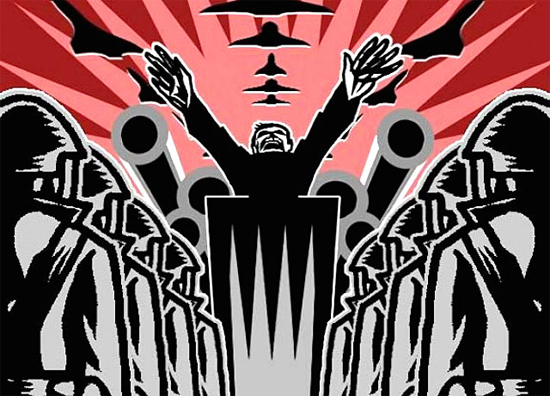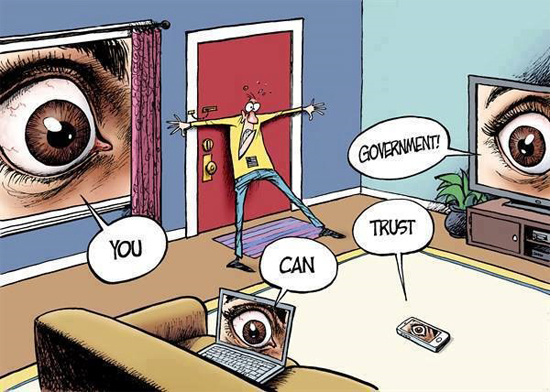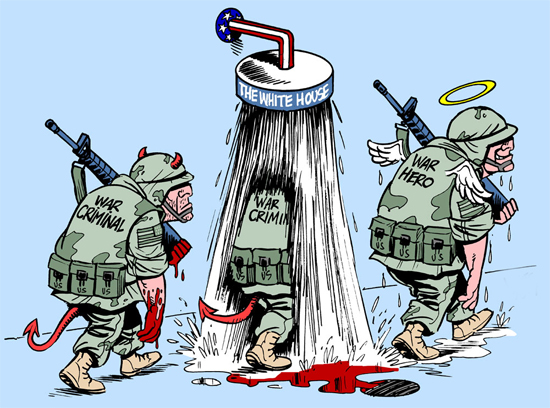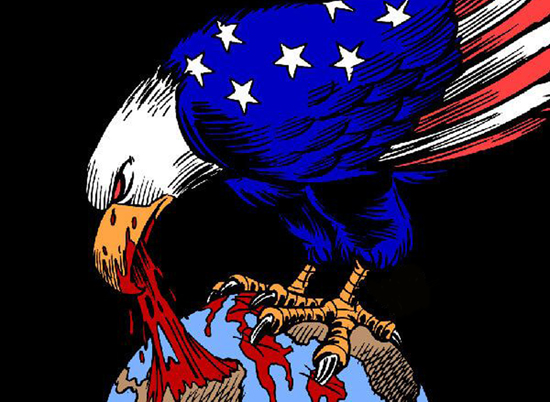CIA atrocities (II)
The following timeline describes just a few of the hundreds of atrocities and crimes committed by the CIA.
Read the first part of the article
1970
Cambodia – The CIA overthrows Prince Sahounek, who is highly popular among Cambodians for keeping them out of the Vietnam War. He is replaced by CIA puppet Lon Nol, who immediately throws Cambodian troops into battle. This unpopular move strengthens once minor opposition parties like the Khmer Rouge, which achieves power in 1975 and massacres millions of its own people.
 1971
1971
Bolivia – After half a decade of CIA-inspired political turmoil, a CIA-backed military coup overthrows the leftist President Juan Torres. In the next two years, dictator Hugo Banzer will have over 2,000 political opponents arrested without trial, then tortured, raped and executed.
Haiti – “Papa Doc” Duvalier dies, leaving his 19-year old son “Baby Doc” Duvalier the dictator of Haiti. His son continues his bloody reign with full knowledge of the CIA.
1972
The Case-Zablocki Act – Congress passes an act requiring congressional review of executive agreements. In theory, this should make CIA operations more accountable. In fact, it is only marginally effective.
Cambodia – Congress votes to cut off CIA funds for its secret war in Cambodia.
Watergate Break-in – President Nixon sends in a team of burglars to wiretap Democratic offices at Watergate. The team members have extensive CIA histories, including James McCord, E. Howard Hunt and five of the Cuban burglars. They work for the Committee to Reelect the President (CREEP), which does dirty work like disrupting Democratic campaigns and laundering Nixon’s illegal campaign contributions. CREEP’s activities are funded and organized by another CIA front, the Mullen Company.
1973
Chile – The CIA overthrows and assassinates Salvador Allende, Latin America’s first democratically elected socialist leader. The problems begin when Allende nationalizes American-owned firms in Chile. ITT offers the CIA $1 million for a coup (reportedly refused). The CIA replaces Allende with General Augusto Pinochet, who will torture and murder thousands of his own countrymen in a crackdown on labor leaders and the political left.
CIA begins internal investigations – William Colby, the Deputy Director for Operations, orders all CIA personnel to report any and all illegal activities they know about. This information is later reported to Congress.
Watergate Scandal – The CIA’s main collaborating newspaper in America, The Washington Post, reports Nixon’s crimes long before any other newspaper takes up the subject. The two reporters, Woodward and Bernstein, make almost no mention of the CIA’s many fingerprints all over the scandal. It is later revealed that Woodward was a naval intelligence briefer to the White House, and knows many important intelligence figures, including General Alexander Haig. His main source, “Deep Throat,” is probably one of those.
CIA Director Helms Fired – President Nixon fires CIA Director Richard Helms for failing to help cover up the Watergate scandal. Helms and Nixon have always disliked each other. The new CIA director is William Colby, who is relatively more open to CIA reform.
1974
CHAOS exposed – Pulitzer prize winning journalist Seymour Hersh publishes a story about Operation CHAOS, the domestic surveillance and infiltration of anti-war and civil rights groups in the U.S. The story sparks national outrage.
Angleton fired – Congress holds hearings on the illegal domestic spying efforts of James Jesus Angleton, the CIA’s chief of counterintelligence. His efforts included mail-opening campaigns and secret surveillance of war protesters. The hearings result in his dismissal from the CIA.
 House clears CIA in Watergate – The House of Representatives clears the CIA of any complicity in Nixon’s Watergate break-in.
House clears CIA in Watergate – The House of Representatives clears the CIA of any complicity in Nixon’s Watergate break-in.
The Hughes Ryan Act – Congress passes an amendment requiring the president to report nonintelligence CIA operations to the relevant congressional committees in a timely fashion.
1975
Australia – The CIA helps topple the democratically elected, left-leaning government of Prime Minister Edward Whitlam. The CIA does this by giving an ultimatum to its Governor-General, John Kerr. Kerr, a longtime CIA collaborator, exercises his constitutional right to dissolve the Whitlam government. The Governor-General is a largely ceremonial position appointed by the Queen; the Prime Minister is democratically elected. The use of this archaic and never-used law stuns the nation.
Angola – Eager to demonstrate American military resolve after its defeat in Vietnam, Henry Kissinger launches a CIA-backed war in Angola. Contrary to Kissinger’s assertions, Angola is a country of little strategic importance and not seriously threatened by communism. The CIA backs the brutal leader of UNITAS, Jonas Savimbi. This polarizes Angolan politics and drives his opponents into the arms of Cuba and the Soviet Union for survival. Congress will cut off funds in 1976, but the CIA is able to run the war off the books until 1984, when funding is legalized again. This entirely pointless war kills over 300,000 Angolans.
“The CIA and the Cult of Intelligence” – Victor Marchetti and John Marks publish this whistle-blowing history of CIA crimes and abuses. Marchetti has spent 14 years in the CIA, eventually becoming an executive assistant to the Deputy Director of Intelligence. Marks has spent five years as an intelligence official in the State Department.
“Inside the Company” – Philip Agee publishes a diary of his life inside the CIA. Agee has worked in covert operations in Latin America during the 60s, and details the crimes in which he took part.
Congress investigates CIA wrong-doing – Public outrage compels Congress to hold hearings on CIA crimes. Senator Frank Church heads the Senate investigation (“The Church Committee”), and Representative Otis Pike heads the House investigation. (Despite a 98 percent incumbency reelection rate, both Church and Pike are defeated in the next elections.) The investigations lead to a number of reforms intended to increase the CIA’s accountability to Congress, including the creation of a standing Senate committee on intelligence. However, the reforms prove ineffective, as the Iran/Contra scandal will show. It turns out the CIA can control, deal with or sidestep Congress with ease.
The Rockefeller Commission – In an attempt to reduce the damage done by the Church Committee, President Ford creates the “Rockefeller Commission” to whitewash CIA history and propose toothless reforms. The commission’s namesake, Vice President Nelson Rockefeller, is himself a major CIA figure. Five of the commission’s eight members are also members of the Council on Foreign Relations, a CIA-dominated organization.
1979
Iran – The CIA fails to predict the fall of the Shah of Iran, a longtime CIA puppet, and the rise of Muslim fundamentalists who are furious at the CIA’s backing of SAVAK, the Shah’s bloodthirsty secret police. In revenge, the Muslims take 52 Americans hostage in the U.S. embassy in Tehran.
Afghanistan – The Soviets invade Afghanistan. The CIA immediately begins supplying arms to any faction willing to fight the occupying Soviets. Such indiscriminate arming means that when the Soviets leave Afghanistan, civil war will erupt. Also, fanatical Muslim extremists now possess state-of-the-art weaponry. One of these is Sheik Abdel Rahman, who will become involved in the World Trade Center bombing in New York.
El Salvador – An idealistic group of young military officers, repulsed by the massacre of the poor, overthrows the right-wing government. However, the U.S. compels the inexperienced officers to include many of the old guard in key positions in their new government. Soon, things are back to “normal” – the military government is repressing and killing poor civilian protesters. Many of the young military and civilian reformers, finding themselves powerless, resign in disgust.
Nicaragua – Anastasio Somoza II, the CIA-backed dictator, falls. The Marxist Sandinistas take over government, and they are initially popular because of their commitment to land and anti-poverty reform. Somoza had a murderous and hated personal army called the National Guard. Remnants of the Guard will become the Contras, who fight a CIA-backed guerilla war against the Sandinista government throughout the 1980s.

1980
El Salvador – The Archbishop of San Salvador, Oscar Romero, pleads with President Carter “Christian to Christian” to stop aiding the military government slaughtering his people. Carter refuses. Shortly afterwards, right-wing leader Roberto D’Aubuisson has Romero shot through the heart while saying Mass. The country soon dissolves into civil war, with the peasants in the hills fighting against the military government. The CIA and U.S. Armed Forces supply the government with overwhelming military and intelligence superiority. CIA-trained death squads roam the countryside, committing atrocities like that of El Mazote in 1982, where they massacre between 700 and 1000 men, women and children. By 1992, some 63,000 Salvadorans will be killed.
1981
Iran/Contra Begins – The CIA begins selling arms to Iran at high prices, using the profits to arm the Contras fighting the Sandinista government in Nicaragua. President Reagan vows that the Sandinistas will be “pressured” until “they say ‘uncle.’” The CIA’s Freedom Fighter’s Manual disbursed to the Contras includes instruction on economic sabotage, propaganda, extortion, bribery, blackmail, interrogation, torture, murder and political assassination.
1983
Honduras – The CIA gives Honduran military officers the Human Resource Exploitation Training Manual – 1983, which teaches how to torture people. Honduras’ notorious “Battalion 316” then uses these techniques, with the CIA’s full knowledge, on thousands of leftist dissidents. At least 184 are murdered.
1984
The Boland Amendment – The last of a series of Boland Amendments is passed. These amendments have reduced CIA aid to the Contras; the last one cuts it off completely. However, CIA Director William Casey is already prepared to “hand off” the operation to Colonel Oliver North, who illegally continues supplying the Contras through the CIA’s informal, secret, and self-financing network. This includes “humanitarian aid” donated by Adolph Coors and William Simon, and military aid funded by Iranian arms sales.
1986
Eugene Hasenfus – Nicaragua shoots down a C-123 transport plane carrying military supplies to the Contras. The lone survivor, Eugene Hasenfus, turns out to be a CIA employee, as are the two dead pilots. The airplane belongs to Southern Air Transport, a CIA front. The incident makes a mockery of President Reagan’s claims that the CIA is not illegally arming the Contras.
Iran/Contra Scandal – Although the details have long been known, the Iran/Contra scandal finally captures the media’s attention in 1986. Congress holds hearings, and several key figures (like Oliver North) lie under oath to protect the intelligence community. CIA Director William Casey dies of brain cancer before Congress can question him. All reforms enacted by Congress after the scandal are purely cosmetic.
Haiti – Rising popular revolt in Haiti means that “Baby Doc” Duvalier will remain “President for Life” only if he has a short one. The U.S., which hates instability in a puppet country, flies the despotic Duvalier to the South of France for a comfortable retirement. The CIA then rigs the upcoming elections in favor of another right-wing military strongman. However, violence keeps the country in political turmoil for another four years. The CIA tries to strengthen the military by creating the National Intelligence Service (SIN), which suppresses popular revolt through torture and assassination.
1989
Panama – The U.S. invades Panama to overthrow a dictator of its own making, General Manuel Noriega. Noriega has been on the CIA’s payroll since 1966, and has been transporting drugs with the CIA’s knowledge since 1972. By the late 80s, Noriega’s growing independence and intransigence have angered Washington… so out he goes.

1990
Haiti – Competing against 10 comparatively wealthy candidates, leftist priest Jean-Bertrand Aristide captures 68 percent of the vote. After only eight months in power, however, the CIA-backed military deposes him. More military dictators brutalize the country, as thousands of Haitian refugees escape the turmoil in barely seaworthy boats. As popular opinion calls for Aristide’s return, the CIA begins a disinformation campaign painting the courageous priest as mentally unstable.
1991
The Gulf War – The U.S. liberates Kuwait from Iraq. But Iraq’s dictator, Saddam Hussein, is another creature of the CIA. With U.S. encouragement, Hussein invaded Iran in 1980. During this costly eight-year war, the CIA built up Hussein’s forces with sophisticated arms, intelligence, training and financial backing. This cemented Hussein’s power at home, allowing him to crush the many internal rebellions that erupted from time to time, sometimes with poison gas. It also gave him all the military might he needed to conduct further adventurism – in Kuwait, for example.
The Fall of the Soviet Union – The CIA fails to predict this most important event of the Cold War. This suggests that it has been so busy undermining governments that it hasn’t been doing its primary job: gathering and analyzing information. The fall of the Soviet Union also robs the CIA of its reason for existence: fighting communism. This leads some to accuse the CIA of intentionally failing to predict the downfall of the Soviet Union. Curiously, the intelligence community’s budget is not significantly reduced after the demise of communism.
1992
Economic Espionage – In the years following the end of the Cold War, the CIA is increasingly used for economic espionage. This involves stealing the technological secrets of competing foreign companies and giving them to American ones. Given the CIA’s clear preference for dirty tricks over mere information gathering, the possibility of serious criminal behavior is very great indeed.
1993
Haiti – The chaos in Haiti grows so bad that President Clinton has no choice but to remove the Haitian military dictator, Raoul Cedras, on threat of U.S. invasion. The U.S. occupiers do not arrest Haiti’s military leaders for crimes against humanity, but instead ensure their safety and rich retirements. Aristide is returned to power only after being forced to accept an agenda favorable to the country’s ruling class.
Epilogue
In a speech before the CIA celebrating its 50th anniversary, President Clinton said: “By necessity, the American people will never know the full story of your courage.”
Clinton’s is a common defense of the CIA: namely, the American people should stop criticizing the CIA because they don’t know what it really does. This, of course, is the heart of the problem in the first place.
An agency that is above criticism is also above moral behavior and reform. Its secrecy and lack of accountability allows its corruption to grow unchecked. Furthermore, Clinton’s statement is simply untrue. The history of the agency is growing painfully clear, especially with the declassification of historical CIA documents. We may not know the details of specific operations, but we do know, quite well, the general behavior of the CIA. These facts began emerging nearly two decades ago at an ever-quickening pace.
Today we have a remarkably accurate and consistent picture, repeated in country after country, and verified from countless different directions. The CIA’s response to this growing knowledge and criticism follows a typical historical pattern. (Indeed, there are remarkable parallels to the Medieval Church’s fight against the Scientific Revolution.) The first journalists and writers to reveal the CIA’s criminal behavior were harassed and censored if they were American writers, and tortured and murdered if they were foreigners. (See Philip Agee’s On the Run for an example of early harassment.)
However, over the last two decades the tide of evidence has become overwhelming, and the CIA has found that it does not have enough fingers to plug every hole in the dike. This is especially true in the age of the Internet, where information flows freely among millions of people. Since censorship is impossible, the Agency must now defend itself with apologetics.
Clinton’s “Americans will never know” defense is a prime example. Another common apologetic is that, “the world is filled with unsavory characters, and we must deal with them if we are to protect American interests at all.” There are two aspects wrong with this. First, it ignores the fact that the CIA has regularly spurned alliances with defenders of democracy, free speech and human rights, preferring the company of military dictators and tyrants. The CIA had moral options available to them, but did not take them. Second, this argument begs several questions. The first is: “Which American interests?” The CIA has courted right-wing dictators because they allow wealthy Americans to exploit the country’s cheap labor and resources. But poor and middle-class Americans pay the price whenever they fight the wars that stem from CIA actions, from Vietnam to the Gulf War to Panama. The second begged question is: “Why should American interests come at the expense of other peoples’ human rights?” The CIA should be abolished, its leadership dismissed and its relevant members tried for crimes against humanity.
The American intelligence community should be rebuilt from the ground up, with the goal of collecting and analyzing information. As for covert action, there are two moral options. The first one is to eliminate covert action completely. But this gives jitters to people worried about the Adolf Hitlers of the world. So a second option is that people can place covert action under extensive and true democratic oversight. For example, a bipartisan Congressional Committee of 40 members could review and veto all aspects of CIA operations upon a majority or super-majority vote.
Which of these two options is best may be the subject of debate, but one aspect is clear: like dictatorship, like monarchy, unaccountable covert operations should die like the dinosaurs they are.
yogaesoteric
April 16, 2021
